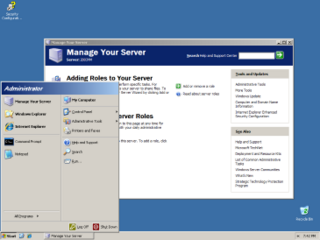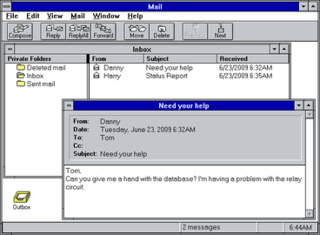Active Directory (AD) is a directory service developed by Microsoft for Windows domain networks. Windows Server operating systems include it as a set of processes and services. Originally, only centralized domain management used Active Directory. However, it ultimately became an umbrella title for various directory-based identity-related services.
In computing, the Internet Message Access Protocol (IMAP) is an Internet standard protocol used by email clients to retrieve email messages from a mail server over a TCP/IP connection. IMAP is defined by RFC 9051.

An email client, email reader or, more formally, message user agent (MUA) or mail user agent is a computer program used to access and manage a user's email.

GNOME Evolution is the official personal information manager for GNOME. It has been an official part of GNOME since Evolution 2.0 was included with the GNOME 2.8 release in September 2004. It combines e-mail, address book, calendar, task list and note-taking features. Its user interface and functionality is similar to Microsoft Outlook. Evolution is free software licensed under the terms of the GNU Lesser General Public License (LGPL).

Microsoft Outlook is a personal information manager software system from Microsoft, available as a part of the Microsoft 365 software suites. Though primarily being popular as an email client for businesses, Outlook also includes functions such as calendaring, task managing, contact managing, note-taking, journal logging, web browsing, and RSS news aggregation.

Windows Server 2003, codenamed "Whistler Server", is the sixth version of the Windows Server operating system produced by Microsoft. It is part of the Windows NT family of operating systems and was released to manufacturing on March 28, 2003 and generally available on April 24, 2003. Windows Server 2003 is the successor to the Server editions of Windows 2000 and the predecessor to Windows Server 2008. An updated version, Windows Server 2003 R2, was released to manufacturing on December 6, 2005. Windows Server 2003 is based on Windows XP.
Messaging Application Programming Interface (MAPI) is an API for Microsoft Windows which allows programs to become email-aware. While MAPI is designed to be independent of the protocol, it is usually used to communicate with Microsoft Exchange Server.
In computing, a Personal Storage Table (.pst) is an open proprietary file format used to store copies of messages, calendar events, and other items within Microsoft software such as Microsoft Exchange Client, Windows Messaging, and Microsoft Outlook. The open format is controlled by Microsoft who provide free specifications and free irrevocable technology licensing.

Microsoft Mail was the name given to several early Microsoft e-mail products for local area networks, primarily two architectures: one for Macintosh networks, and one for PC architecture-based LANs. All were eventually replaced by the Exchange and Outlook product lines.
Push email is an email system that provides an always-on capability, in which when new email arrives at the mail delivery agent (MDA), it is immediately, actively transferred (pushed) by the MDA to the mail user agent (MUA), also called the email client, so that the end-user can see incoming email immediately. This is in contrast with systems that check for new incoming mail every so often, on a schedule. Email clients include smartphones and, less strictly, IMAP personal computer mail applications.

Windows Live Mail is a discontinued freeware email client from Microsoft. It was the successor to Windows Mail in Windows Vista, which was the successor to Outlook Express in Windows XP and Windows 98. Windows Live Mail is designed to run on Windows 7 and Windows Server 2008 R2, but is also compatible with Windows 8 and Windows 10, even though Microsoft bundles a new email client, named Windows Mail, with the latter. In addition to email, Windows Live Mail also features a calendar, an RSS feed reader, and a Usenet newsreader.

Outlook.com, formerly Hotmail, is a free personal email service offered by Microsoft. This includes a webmail interface featuring mail, calendaring, contacts, and tasks services. Outlook can also be accessed via email clients using the IMAP or POP protocols.

Mimecast Limited is an American–British, Jersey-domiciled company specializing in cloud-based email management for Microsoft Exchange and Microsoft Office 365, including security, archiving, and continuity services to protect business mail.
Exchange ActiveSync is a proprietary protocol designed for the synchronization of email, contacts, calendar, tasks, and notes from a messaging server to a smartphone or other mobile devices. The protocol also provides mobile device management and policy controls. The protocol is based on XML. The mobile device communicates over HTTP or HTTPS.

GroupWise is a messaging and collaboration platform from OpenText that supports email, calendaring, personal information management, instant messaging, and document management. The GroupWise platform consists of desktop client software, which is available for Windows,, and the server software, which is supported on Windows Server and Linux.
MailSite is a commercial mail server, calendar software, contact manager and collaborative software that was developed by Rockliffe Systems. It was one of the first mail servers to run on Windows NT using Internet standards when version 1.2 was released in 1996. Additionally, MailSite has been in continual development since 1996 with version 10 released in 2013, and runs on a single Windows Server as well as on a cluster of Windows Server computers. MailSite works natively with Microsoft Outlook versions 2007 to 2013 for mail, calendar and contacts without requiring any Outlook plug-ins, as well as including an Exchange ActiveSync (EAS) server for synchronizing mail, calendar and contacts with mobile devices. MailSite also works with Internet Standards-based mail clients such as Mozilla Thunderbird.

Zentyal is a open source email and groupware solution based on Ubuntu Linux. The latest release took place on February 26, 2024.

Mail is an email client developed by Microsoft and included in Windows Vista and later versions of Windows. It is available as the successor to Outlook Express, which was either included with, or released for Internet Explorer 3.0 and later versions of Internet Explorer. It is set to be replaced by Outlook for Windows.
The first release of Microsoft Exchange Server was version 4.0 in April 1996, when it was sold as an upgrade to Microsoft Mail 3.5. Before that, Microsoft Mail v2.0 was replaced in 1991 by "Microsoft Mail for PC Networks v2.1", based on Network Courier from its acquisition of Consumers Software. Exchange Server was an entirely new X.400-based client–server mail system with a single database store that also supported X.500 directory services. During its development, Microsoft migrated their own internal email from a Xenix-based system to Exchange Server from April 1993, with all 32,000 Microsoft mailboxes on Exchange by late 1996. The directory used by Exchange Server eventually became Microsoft's Active Directory service, an LDAP-compliant directory service. Active Directory was integrated into Windows 2000 as the foundation of Windows domains.
Kopano is an open-source groupware application suite originally based on Zarafa. The initial version of Kopano Core (KC) was forked from the then-current release of Zarafa Collaboration Platform, and superseded ZCP in terms of lineage as ZCP switched to maintenance mode with patches flowing from KC. Kopano WebApp similarly descended from Zarafa WebApp. Since October 2017, Kopano Core is also known more specifically as Kopano Groupware Core, since Kopano B.V. developed more products that were not directly requiring groupware components.









